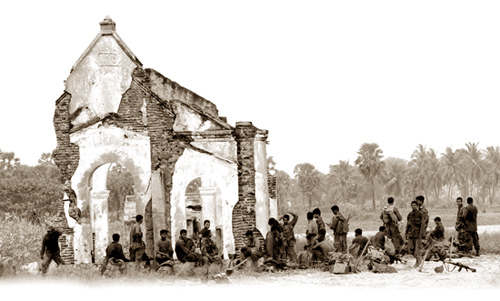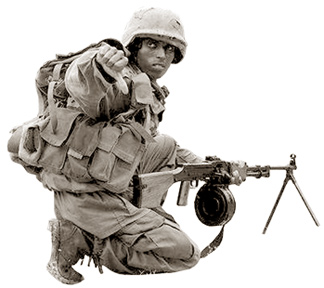The troop thrust to Wanni
 The
last three months of the year 2007 was considered as the most crucial
stage of the Wanni liberation operation. That was crucial not only due
to the preliminary attempts to breach the LTTE Forward Defences were
made during this period, but it was a period when both Security Forces
and the LTTE displayed their military strategies to face the battles in
Wanni. The
last three months of the year 2007 was considered as the most crucial
stage of the Wanni liberation operation. That was crucial not only due
to the preliminary attempts to breach the LTTE Forward Defences were
made during this period, but it was a period when both Security Forces
and the LTTE displayed their military strategies to face the battles in
Wanni.
It was the period the Sri Lankan military at least gave a hint of how
they were going to fight the war against the LTTE in Wanni. Although the
LTTE posed stiff resistance to the troops operating in the 57 Division
front West of Vavuniya, they had to re-think their strategies to face
the real threat once Sri Lanka Army opened up its second offensive front
from the Mannar in September 2007.
The Task Force I which was later elevated as the 58 Division of the
Sri Lanka Army following the capture of Kilinochchi and Elephant Pass,
was formed to open up another battlefront under the Command of Brigadier
Shavendra Silva.
 Although Brigadier Chagie Gallage was due to take charge of this
battle front, the SLA had to abandon that decision as Brigadier Gallage
had to undergone immediate heart surgery. Although Brigadier Chagie Gallage was due to take charge of this
battle front, the SLA had to abandon that decision as Brigadier Gallage
had to undergone immediate heart surgery.
Due to this situation Brigadier Shavendra Silva, who was then Air
Mobile Brigade Commander based in Jaffna, was appointed as the Commander
of the 58 Division and also as the Commando Brigade Commander.
The Task Force I established its base in Nanattan South of Mannar at
the initial stages and deployed its troops along the Mannar-Vavuniya
Road. The LTTE had its defence lines closer to Mannar-Vavuniya road and
the Police and the Police Special Task Force were manning the bunker
lines along this road.
They did not have an opportunity to even bathe in the giant tank
which was located closer to the Mannar-Vavuniya Road, in fear of LTTE
sniper attacks.
However, their fears about possible LTTE attacks from South of Mannar,
were relieved with the capture of Silavathura in the first week of
September.
The LTTE never thought of fighting different battle fronts at once as
they had already committed their cadres in the Madhu front to continue
their fight with the 57 Division.
As described in the earlier article there was intense fighting in
Thampanai and the areas surrounding the sacred Madhu shrine by the time
58 Division commenced it operations in the Mannar front.
However, the two battle fronts were completely different, as the 57
Division troops had to go through jungle patches while 58 Division
troops had to fight in an open terrain in massive paddy fields.
Considering the big challenge the LTTE faced, they made a series of
attempts to thwart the efforts of the Sri Lanka Army to open up this
battle front and continued with series of bomb attacks in the South to
divert the troops focus outside the battle front. They tried their best
to prevent the troops deployed in the Eastern theatre being shifted to
the Wanni battle front.
The attack on Thalgasmanakada Army detachment in mid October, 2008
goes down as one such attempt by the LTTE.
 The SLA and the Police Special Task Force had to deploy their troops
to conduct search operations in the area as LTTE infiltration to the
Yala National Park posed a severe security threat to the Eastern border
villages and the Southern part of the country. The SLA and the Police Special Task Force had to deploy their troops
to conduct search operations in the area as LTTE infiltration to the
Yala National Park posed a severe security threat to the Eastern border
villages and the Southern part of the country.
However, these attempts could not hinder the Security Forces from
opening the battle front in Mannar and their forward march through the
Mannar Rice bowl, one of the most fertile paddy lands in the country.
The LTTE, which was prepared to face conventional type of battle,
like the way they fought Jaya Sikuru operation in the late 1990s, had to
readjust their strategies to face this situation.
The primary target of the 58 Division was to capture the LTTE
defences in Uyilanakulam as the LTTE made use of the entry exit point
there to harass innocent civilians who were travelling to and from the
cleared areas in Mannar for their daily needs.
When troops of the 57 Division continued their battle to capture
Thampanai village West of Vavuniya, the 58 Division troops also started
their battle, closely studying the battle ground which was considered as
one of the difficult terrains to engage with enemy.
It was on December 22, the 58 Division came out with its first
military victory after capturing the LTTE’s Uyilankulam checkpoint after
a fierce battle.
Troops of the 58 Division on December 22 launched a major assault on
the Uyilankulam LTTE entry - exit point and captured 10 Tiger bunkers
and the ICRC checkpoint at the LTTE’s end.
Military officials confirmed that eight Tiger cadres were killed and
14 injured as troops captured 10 Tiger bunkers in the Uyilankulam
checkpoint around 10 a.m. on December 22, 2007. One soldier sacrificed
his life and six others sustained injuries during the confrontation.
The LTTE entry - exit point was located some 500 metres away from the
Security Forces’ defences at the Uyilankulam checkpoint used as a
gateway to the Wanni from the cleared areas in Mannar.
The attack on the Uyilankulam checkpoint came as a surprise for the
LTTE although they were aware of the fact that troops were taking time
to launch their first assault on their defences. Therefore, Security
Forces had to thwart many counter attacks by the LTTE. It was around 2
p.m. on December 22, 2007 troops foiled one major attempt by the LTTE to
capture the LTTE entry exit point amidst rains of artillery and mortar
fire. Troops also countered LTTE artillery and mortar fire killing
dozens of Tiger cadres.
Tiger leader Bhanu, who led Tiger cadres to recapture the entry -
exit point gave up his attempt after making several aborted attempts.
That heralded the fall of the LTTE in the Mannar front. Since LTTE
too was in a disadvantageous position in the Mannar front, due to the
open terrain with the capture of Uyilankulam entry exit point, the LTTE
started its newest strategy of creating massive ditch cum earth bunds
covering the entire defence lines and laid mines all over the ‘Mannar
Rice bowl’.
According to military officials, the LTTE created those massive ditch
cum earth bunds under the supervision of Swarnam who had arrived there
after their defeat in the Eastern theatre.
Basically, their attempt was to delay the advance of the troops
across the Mannar Rice Bowl to take their own time to defend their
strategic bases on the North Western coast and to prevent civilians
crossing into Government controlled areas.
Although the LTTE achieved its primary objective of delaying the
troops advance, they could not stop the troops from capturing these
ditch cum earth bunds which were filled with anti personnel mines as
troops found many strategies to overcome those obstacles.
The Special Infantry Operation Training given for most of the
infantry troops by that time helped the infantry troops to operate with
the Commando and SF troops. With the capture of the Uyilankulam Entry
Exit Point, the Infantry Troops and Commandos continued their attrition
on the LTTE by continuously engaging their strong points after
infiltrating their defences. The Sri Lanka Air Force too gave close
support to the ground troops neutralising many of their bunkers and
other gun positions.
It was on March 04, 2008 the LTTE suffered its second setback in the
Mannar front when the 58 Division troops made yet another move advancing
towards Tiger held territory overrunning their cross loading point in
Uyilankulam and a key position in Palakkuli Easts, inflicting heavy
damages to the outfit.
The heavily fortified LTTE cross loading point with six strongly
built bunker lines and a building complex at Karukkankulam used as the
cross loading point at Uyilankulam fell to the ground troops at around 6
a.m on March 4, 2008.
The LTTE used this cross loading point to search vehicles entering
and leaving uncleared areas in Mannar through the Uyilankulam entry exit
point. Heavy fighting broke out in Uyilankulam as two companies of the
10th Gajaba Regiment which was under the command of Lt. Colonel Sarada
Samarakoon advanced nearly one kilometre ahead of the defences in the
early hours of March 4.
Tiger cadres manning the defence line abandoned their positions and
withdrew further towards the north of Mannar in the face of the fierce
offensive launched after cutting off all LTTE reinforcements to the
battle area.
Two soldiers were killed and five injured during the fight that
lasted for several hours yesterday morning. Meanwhile, 12 Gemunu Watch
troops under the command of Lt. Colonel Harendra Dunuwila operating in
Palakkuli East also captured a 700 metres long stretch in a coconut
cultivation located in the area on the same day the 10 GR troops
captured Uyilankulam cross loading point.
Troops effectively repulsed subsequent LTTE attempts to recapture
their lost territory under the command of Bhanu and Lakshman with Air
Force providing air support targeting their key gun position north of
Giant Tank.
It was after the capture of the cross loading point in Uyilankulam
the LTTE shifted their heavy calibre artillery guns to North of Mannar
region as the battle in Mannar had already reached a decisive phase with
more than half of the Mannar ‘Rice Bowl’ area coming under the control
of the Security Forces.
By the end of March the LTTE used almost all of their heavy calibre
artillery guns in the Mannar theatre, even directing artillery rounds
into Mannar town.
The LTTE too used 130mm artillery guns available with them in the
Mannar theatre to thwart the troops advance to the thick jungles in the
Mannar-Vavuniya border. This was apart from the use of 122 mm artillery
and 80mm mortars frequently.
The LTTE directed artillery fire from Periyamadu area, keeping a
safer distance from the Security Forces. The main reason for them to
muster artillery guns to the Mannar front was that they could
effectively to launch major assaults on the advancing troops as the
troops had to cross an open terrain in fallow paddy lands to reach Tiger
defences. As battles continued in the middle of the Mannar Rice Bowl,
LTTE went ahead with its overall security plan constructing more earth
bunds to delay the advance of the troops.
However, by this time the LTTE had to think of two strategic
locations simultaneously - the Mannar Rice Bowl and the Madhu shrine
which were equally important for them, both strategically and
militarily.
Therefore, the LTTE mustered their its strength to the Mannar and the
Vavuniya front as it was on the verge of losing its prestigious ground
in the Madhu frequently used by the LTTE to achieve their narrow
objectives militarily and politically.
They used the Madhu shrine to achieve both militaristic and political
objectives as they constructed new defence line covering Uyilankulam
Madhu road taking the cover of pilgrims attending the Madhu feast from
Uyilankulam.
The 600 metres long earth bund created covering the entire road was
later captured by the 10 Gajaba Regiment troops under the command of Lt.
Colonel Sarada Samarakoon amid intense LTTE mortar and artillery fire.
Not only did they capture that earth bund but also extended their
defence line in both sides of the Uyilankulam-Parappakandal-Andankulam
Road.
With the securing of this earth bund, paths were cleared from various
directions to take the Madhu area under the control of the Security
Forces.
By March 2007 both Mannar Rice Bowl and the Madhu Shrine was about to
fall to the hands of the Security Forces, as the LTTE had to face
another battle front in the Weli Oya apart from the main battle in
Mannar and Vavuniya as the SLA with its successful recruitment drive was
able to form another offensive Division, the 59 Division.
The 59 Division was formed under the command of Brigadier Nandana
Udawatta who was the Deputy General Officer Commanding of the 57
Division.Not only in the Mannar and Vavuniya fronts, the troops in the
Weli Oya front also produced positive results heading towards the
Mullaitivu direction from the Kokkuthuduval-Parakramapura front.
So the LTTE had to face a big headache with regard to its mobility of
cadres - four different battle fronts including that of the Jaffna front
to defend Wanni from the Security Forces.
|

